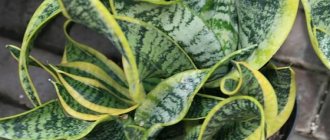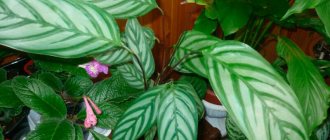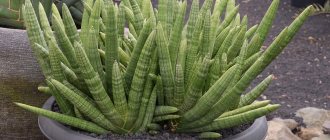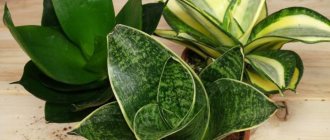Sansevieria trifasciata is without a doubt one of the most aesthetically pleasing and low-maintenance indoor plants. In recent years, Sansevieria has increasingly appeared in the interiors of not only government institutions, offices and cafes, but also in the interiors of apartments.
There are a huge number of Sansevieria varieties, and even more names. The indoor flower is popularly called “mother-in-law’s tongue”, “pike tail”, and the name Sansevieria itself can have such a variant as “Sansevieria”.
In this article we will look at:
- Caring for sansevieria (what conditions are needed, how to water it, do you need to feed it?)
- Types of Sansevieria.
- Reproduction of Sansevieria (how to plant and how to transplant the Pike Tail flower? How to transplant Sansevieria into another pot?)
- How Sansevieria blooms. (does it bloom at all? Types, timing, photos and names)
Description of the plant
The herbaceous flower is not an annual and not demanding, which is why it is popular. The stemless evergreen sansevieria trifasciata of the Asparagus family is found “in the wild” in the tropics and subtropics. Most often this is India and South Florida, but they have learned to cultivate and successfully propagate mother-in-law’s language in our area.
Snakeskin (in this case, the name, surprisingly, comes from the color, and not from the shape) is included in the genus Agave, which, meanwhile, contains more than 60 species.
If you thought that mother-in-law’s tongue is characterized by a lot of attention and constant care, then you don’t have to worry - everything will be fine with the Sansevieria flower, even skipping watering or flooding it with water, and if you want to quickly plant it in other pots, then vegetative care will help propagation by leaf.
The Sansevieria plant is a succulent (a plant that stores water in its leaves), which explains its resistance to heat and drought. It is closely related to dracaena and yucca. It grows in rosettes of leaves that extend immediately from the rhizome.
The leaves are mostly dark or light green in color. It, in turn, is diluted with white or yellowish stripes, specks or spots that look like scales. The leaf shape varies from oval to xiphoid.
They grow vertically, but not as a rule. They can grow in different directions, grow in a spiral or parallel to the ground, but this is typical only for certain species.
The growth cone of the leaf is a sharp point; under no circumstances should it be broken off. If you have ever observed such a process in vansevieria, you know that after the tip is broken off, it dries out and turns yellow. This significantly impairs cell growth and the growth rate of the succulent itself, respectively.
Sansevieria often grows very quickly and the bush puts out new leaves every month, which can be replanted in a couple of days/weeks. But there are also long-growing species that produce 2-3 leaves per year.
Mostly people grow the following species:
- Sansevieria laurenti.
- Sansevieria three-lane.
- Pinguecula.
- Hunny.
- Cylindrical.
- Trifasciata.
Pike tail: harm or benefit
This plant is an evergreen; it tolerates lack of watering or dry indoor conditions due to the waxy coating on the leaves and creeping rhizome.
Pike tail blooms in a rather original way - the buds are tied on a peduncle growing from the same rosette as the foliage.
The flower petals are white-green in color, and their aroma is intense, quite pleasant and has bright notes of vanilla. As a rule, flowers open in the late afternoon and close their petals by dawn.
This plant is medicinal, and the range of its uses is quite wide - it is used:
- as a diuretic, diaphoretic, choleretic agent
- for bronchitis and cough
- as an antiviral and immune booster
- to get rid of inflammatory processes in the female reproductive system
- for the treatment of wounds, skin fungus and inflammation of the skin - the leaf of the plant is kneaded with your hands and applied to the damaged area, the effect of treatment is noticeable the very next day
Pike tail leaves contain essential oils that have a positive effect on the nervous system, they help get rid of bad mood, headaches, nervousness, relieve tension and ease difficulty breathing.
The harm to the plant, which is often mentioned, as a rule, lies only in superstitions and signs hovering around the pike tail.
And no real contraindications prohibiting keeping sansevieria in housing have been identified by either botanists or owners, except for the ban on eating the plant for people or animals, since the saponins it contains cause poisoning, vomiting and nausea.
Types, varieties of characteristics of the Sansevieria flower
Before we move on to the topic of proper care at home, let's look at the varieties of Sansevieria. As mentioned above, there are a huge number of species, and if we consider absolutely everything and their relatives, it would take quite a long time, therefore, we will discuss only the most relevant types of Sansevieria.
Sansevieria Moonshine
Sansevieria Moonshine (from English - moonlight or silver moon). Indeed, the flower is incredibly similar to the moon, almost white and cold. The leaves of the plant are oval and grow in different directions in rosettes.
This variety of sansevieria loves light, but now it dies from direct sunlight. They leave burns on the leaves, especially if after watering drops of water remain on the leaves and the sun gradually burns them out.
This requires moderate watering 1-3 times a week; if water accumulates in the pot’s base, then you definitely need to water it. The plant is more resistant to temperatures than some other species, but can withstand no more than 35 and no less than 15 degrees for long periods.
It is interesting that in case of violations of conditions or diseases that we may not suspect, the flower will immediately report, starting to lose its characteristic color.
The leaves are very dense, up to 5-6 cm wide, reaching a height of no more than 30-35 cm. They fit perfectly on the kitchen window and on the shelves of the home interior.
Sansevieria Hyacinth sansevieria sansevieria hyacinthoides
The houseplant mother-in-law's tongue (Sansevieria hyacinthoides) is a member of the Amaryllis, Liliaceae and Agave families, and is related to Dracaena. This is the type you most often observed in the interiors of public places. This is not surprising, because such a flower reaches up to a meter in height.
Popular names among people:
- Mother-in-law's tongue.
- The tongue of the devil.
- The language of the gin.
- Pike tail.
- Hemp bowstring.
- Snake plant or snake tongue, snake scales.
leaf fibers are dark green, or with a milky admixture. The scaly color can be either lighter or darker than the main color of the leaf, and such leaves can grow from the same rosette. From personal experience I can say that by the standards of succulents they grow quite quickly and within half a year the pot was full, and I even managed to replant a couple. Provided that the ends not only did not break off, but were not even touched by hands.
Note: short ones grow better alone, while tall ones grow better in a group.
Photos of Sansevieria flowers are quite difficult to find, and even more so to see in real life, since they will bloom extremely rarely. The flowers are collected in spike-shaped racemes of pale white color with long stamens and the same white anthers. This is already a generative method of reproduction.
My flowers also bloomed, but that was the last time 7 years ago. Due to the move, we put them in the far corner and forgot, we didn’t water them, it was summer. They bloomed and as a result there are orange-red berries, this should be hidden from children immediately, since the berries are poisonous, like the leaves of the flower themselves. Inside the berries (pericarp) there are seeds with a seed coat and sperm.
It grows originally in the Eastern Cape, Botswana and Namibia.
Sansevieria trifasciat
Three-lane Sansevieria (or Laurenti) belongs to the Nolinaceae class. It shares characteristics with other representatives of the Sansevieria species. Caring for three-lane sansevieria includes constant watering, ventilation, diffused light and careful handling; it is not advisable to move it. Otherwise, the approach is almost identical to the others. also lives in tropical regions of Africa and Asia.
The belt-shaped leaves reach a meter in height, the rhizome is fibrous and highly branched. It grows in small rosettes, twisting at the root, vertically upward. The color is dull green, scaly (pinnate) with yellowish-white stripes running along the fibers of the leaf.
Divided into varieties, it is one of the tallest representatives of the species. The stripes run along the edge of the leaf, the width of which varies depending on the age and variety. There are also low-growing, slow-growing varieties.
The stripes are not necessarily always yellow, they can also be dark green, silver or almost white; in some cases, related varieties without stripes are found, despite the fact that they are the ones that distinguish the variety. Just like the shape of the leaf can be very different.
Caring for sansevieria at home is not at all difficult. It will grow well both in bright light and in room lighting, but provided that it illuminates the leaves for at least 16 hours a day. If the temperature outside does not drop below 15 degrees, then it will be comfortable outside.
Watering with tap water is possible, since the flower has an extremely positive attitude towards lime. cutting it is not required, much less strictly prohibited. Grows well in a mixture of turf, leaf soil and sand. You can buy simple soil for plants in the store, you can mix the sand yourself and in a shallow pot the sansevieria will delight you with its rapid growth.
Frequent feeding is not needed; sometimes, if you don’t want to keep an eye on it, you can do without feeding.
How to propagate Sansevieria? It’s still a leaf in the spring, but we’ll look at how to replant a pike tail correctly in the following sections.
Sansevieria Laurenti
The flower deserves its resemblance to the three-banded one and its unification into one variety due to its scaly color, the difference in the stripes, their presence, shape and color. Laurenti can be called a variety of three-lane Sansevieria.
Sansevieria Nelson
One of the Laurenti varieties, bred by the botanist O. Nelson in 1944 and patented as his variety, named after the creator. Differs from Laurenti:
- Numerous leaves. (frequent location).
- Location. (grow straight up).
- Shape. (much more familiar Laurenti).
- Color. (dark green leaves with longitudinal stripes).
The variety is quite complex and is not suitable for beginners in floriculture, as it is slow-growing, and even when transplanting a pike tail, in this case it is worth replanting it with a rhizome, only that tail will retain its morphological characteristics. Otherwise, when transplanted with leaves, it will return to its original form, i.e. Laurenti.
Sansevieria Hanni
The leaves have characteristic stripes since Hanni was developed from the Laurenti variety in 1941. A low-growing plant, one rosette per pot will be enough. The leaves grow in a spiral and the older they become, the darker and coarser they become. They will stand well on shelves with books or on the outer shelves of a closet, where there is a sufficient amount of diffused light.
Beneficial features
The perennial succulent is used in folk and traditional medicine. Along with aloe juice, they are successfully treated with sansevieria juice, as well as a decoction of the root and even the smell of the flower. The methods of using Sansevieria at home and in distant countries differ little.
External and internal use of the plant is justified for diseases such as:
- colds: drops of juice diluted with water help with runny nose and ear pain, expectorant;
- for the treatment of skin problems: burns, wounds, dermatitis, scabies, ulcerative inflammation;
- gynecology: inflammation of the appendages, cystitis;
- intestines: laxative effect;
- hypertension and headache:
- The smell of dry leaves stabilizes blood pressure and relieves headaches.
Sansevieria should be used for medicinal purposes with caution and only after consultation with a doctor.
The plant is also used in cosmetology.
“Pike tail” contains glycosides that are highly soluble in water and alcohol. Organic acids contain saponin, which means soap in Latin. It is included in cosmetics and detergents. Despite the fact that the homeland of indoor Sansevieria is hot countries, the flower has taken root well on the windowsills of Europe and the northern continents. A spectacular evergreen unpretentious plant can be grown at home and in office premises. Sansevieria not only decorates a room, but also fills it with positive energy.
Applications of Sansevieria
In its homeland, sansevieria is successfully used as a hedge. Its leaves contain valuable technical fiber, from which local residents used to make bow strings. Currently, in tropical countries, certain types of sansevieria are cultivated to produce this fiber. Sansevieria is also a medicinal plant. It is used to treat cystitis and inflammation of the appendages. With the help of this plant, you can increase resistance to viral and colds and enhance adaptive abilities.
Sansevieria has been grown in Europe as an ornamental plant since the 18th century, considered an unpretentious and hardy indoor plant that is suitable even for the novice gardener. In summer, Sansevieria graces man-made landscapes, as its showy leaves create the perfect backdrop for plants with small flowers or feathery leaves. This plant is used for landscaping winter gardens and creating compositional arrangements.
Sources
- https://vusadebke.com/cvetovodstvo/komnatnye-cvety-i-rasteniya/dekorativnolistnye/kak-vyglyadit-sansevera.html
- https://FB.ru/article/164327/otkuda-rodom-schuchiy-hvost-rodina-rasteniya-i-poleznyie-svoystva
- https://pion.guru/rasteniya/sansevera
- https://prorasteniya.com/komnatnye/sukkulenty/sansevera.html
- https://podokonnik.temadnya.com/1394154088869137311/sansevieriya-rodina-rasteniya/
[collapse]
Priming
Mother-in-law's tongue grows remarkably well in a variety of lighting conditions. From bright sun, indirect light or low light, not to mention their beauty and impact on air quality.
Such an indoor plant, which requires almost no care, does not even always need to be fed, but just watering is enough. But still, when transplanting and planting in general, you need to respect the composition of the soil, which will preserve the health of your plant.
What kind of soil does mother-in-law's tongue need for better plant growth?
As a succulent, the flower is vulnerable to root rot. This means that it is important to have a well-drained soil mixture.
Choose a pot with drainage holes. (These are small holes at the bottom of the pot, you can make them yourself). Choose from one of the potting mixes designed for growing cacti and succulents, or make your own. It will be nice if you put 2-3 centimeter pebbles in a pot (mixed with soil).
You can use a plastic pot, but a terracotta pot usually has the ideal amount of drainage.
There are several excellent options for ready-made potting mix, but generally three brands stand out:
- Miracle Growth
Manufactured by one of the most renowned plant care brands, Miracle-Gro. Their cactus, palm and citrus pots combine perlite and sand with a variety of woody ingredients to provide fast drainage and a nutritious planting medium.
- Ramsey Succulent Mix
Seaweed is a key ingredient in Ramsey's luscious soil. The mixture also combines perlite and sand.
- rePotme Mix for cacti and succulents
It contains tiny pieces of bark, pumice, stalite and diatomaceous earth. Diamite provides this mixture with excellent natural pest control.
We divide the rhizomes
Large plants can be propagated this way
It is only important to remember that each separated part must have a growth point. The rhizome taken out of the pot is cut with a sharp knife into the required number of “seedlings”
The cut areas must be dried for several hours and powdered with crushed coal, after which the separated fragments are planted in pots with soil prepared in advance.
Sansevieria
This prince lived in the 18th century, he did a lot for the development of botany. In England, Sansevieria is known as the snake plant, the devil's tongue. Mother-in-law's tongue is another name, apparently given to the plant by the British for the length and pointed shape of the leaves.
The tiger orchid is called the tail in China, in Japan - the tiger's tail, in America - the snake's braid. Pasha's sword is the Turkish nickname for the flower, the sword of St. George is Brazilian.
The ancient Germans grew Sansevieria (African hemp) to make fiber.
Lighting
Although piketail moths survive in a variety of conditions, it is important to create a suitable environment for their growth. Snake plants can grow in a variety of light intensities, from low to high. However, they prefer diffused light.
Mother-in-law's tongue can grow in shady corners and in low light. These versatile plants can tolerate lower light conditions than most others.
If, for example, you place a plant in a dark corner of the office, it will not die from lack of light, but it will not become as bright as another flower exposed to indirect sunlight.
Therefore, avoid placing succulents in rooms without windows or natural light.
The ideal location would be near an east-facing window that gets plenty of sunlight in the morning. A corner or center of a room that does not receive direct light is also the best location for a snake plant.
Snake plants can tolerate high light levels. They will grow in full sun. However, if your plant was grown indoors, placing it in direct sunlight may cause burns.
It is always best to use indirect sunlight.
How many names does he have?
Let's start, perhaps, with the official language of almost all terms - Latin. Sansevieria (sansevieria) - this is exactly what the name of this representative of the decorative fauna actually sounds like. The flower was named in honor of the philanthropist and botany lover, the Italian aristocrat Raimondo de Sangro, Prince von Sansevierio, who lived in the 18th century.
Pike tail is the name given to this plant by people who saw a pattern in the stripes on the leaves of one of the species that was similar to the color of a river predator. Another bright epithet that has taken root among us is mother-in-law’s tongue. Most likely, a parallel should be drawn here with the long tongue of the heroine of such popular jokes among us. It is difficult to find any other reason for the appearance of such a name, other than the ineradicable sense of humor of the Russian people.
However, in the search for interesting names that at least somewhat accurately characterize sansevieria, our people are not at all original. The Germans call this plant African hemp, the British - the tongue of the devil, or leopard lily, the Americans - snake skin, which indicates the popularity of the species in different countries.
Watering
Watering is carried out in two ways:
- On one's own.
You get the flower 1-3 times a week, without touching the leaves, but rubbing them.
- Automatic watering. For outdoors or large tanks.
Self-watering seeders provide deep and thorough watering of the topsoil after the first planting. This is important because the plant's roots must first grow into the reservoir in order to drink from it. Before using the reservoir, water the plant from above for two to four weeks.
Reproduction methods
There are several ways to obtain new specimens of Sansevieria.
Side shoots
With this method, the shoot is separated from the parent plant. To do this, the rhizome that connects the baby to the “mother” is cut with a knife. The cut area is sprinkled with crushed coal, then planted in a separate container with fresh soil. You need to handle the newcomer with care: when watering, avoid getting liquid on the leaves, and also do not feed.
Leaf
For such propagation, old lower and healthy leaves are taken. They are cut into pieces of 5-10 cm and left for a couple of days at room temperature. After such drying, the cuttings are planted vertically in damp sand or peat to a depth of 2 cm. It is very important here not to confuse the top and bottom of the piece, because if planted on the wrong side, the roots will not grow. The distance between young tails is 2-4 cm.
The top of the “bed” is covered with cans or plastic bags, which must be removed once a day to provide ventilation for the cuttings. Water as needed through a tray. Two to three months later, after the roots and stems appear, the plants are picked. This method is only suitable for varieties with green leaves; variegated stripes are not inherited in this way.
Dividing the rhizome
By dividing the rhizome, adult specimens with a developed root system are propagated. It is necessary to divide the rhizome so that each piece contains at least one bud. The sections are treated with fungicide or crushed coal, then planted in the ground.
Trimming
Mother-in-law's tongue is known for its hardiness and rather slow growth, therefore, it will tolerate pruning very well at any time of the year. To successfully carry out pruning and not harm the plant, it is best to do it in spring or early summer.
Pruning does stress the plant, so if your succulent is in poor condition, it's best to first improve general care, encourage new healthy growth, and then prune to promote a quick recovery.
However, snake tongue does not need to be pruned as often as some plants, but there are three main reasons why you should do the pruning from time to time.
- Snake plants grow in size by spreading from rhizomes under the soil. The new leaves will gradually increase the spread of the plant and you will soon find that it completely fills the container it is in. This can lead to slower growth and a deterioration in the general condition of the flower.
- The roots of the snake tongue can be longer than the plant itself as a whole. A plant that seems comfortable enough in its pot at first glance may have roots that wrap tightly around the inside of the pot.
What benefits does a pike tail bring?
This plant is used in a variety of areas. First of all, it is an excellent choleretic agent. Traditional medicine uses sansevieria as an excellent anti-inflammatory agent. Leaves applied to the wound promote rapid healing.
Such properties allow the home plant to be used externally or as an internal preparation. Homemade pike tail leaves can be used similarly to aloe leaves; they should be applied to the wound for quick healing.
Almost all elements of homemade pike tail are used in medicine. Finely chopped root has a strong immunomodulatory effect. Medicinal decoctions are made from it, which have a preventive effect on colds.
In addition, homemade pike tail has several useful properties:
- Antiviral.
- Fungicidal.
- Diuretic.
Of course, if you use this home plant haphazardly, you can harm yourself. To use it, you need to know well the individual tolerance of your body and the diagnosis of the disease.
In principle, the plant is absolutely harmless. It can be used to treat a wide variety of colds:
- Cough.
- Bronchitis.
- ORZ.
The use of Sansevieria in the treatment of other diseases has a great positive effect:
- acne;
- dermatitis;
- skin ulcers;
- women's diseases.
Medicinal properties of the plant “Pike tail”
According to traditional medicine, the plant has a beneficial effect on the human nervous state, it perfectly purifies the air. The indoor microclimate improves.
Medical professionals are skeptical about the benefits of this plant. However, it has long been recognized as a medicinal plant, but not widely used in comparison with, say, chamomile.
It must be said that the “pike tail”, when properly cared for, reduces the harmful effects of radiation from the computer, which is why it is often installed next to the monitor.
The mythical properties of the plant, which cannot be explained by natural laws, are also of interest. For example, where there is a home flower, people very rarely quarrel, there are no scandals or petty squabbles.
People who are often near the flower and who constantly care for it begin to feel more confident, and men's potency improves.
The human body practically ceases to feel magnetic storms. The room is cleared of viruses, especially ARVI carriers.
“Pike tail” helps if a person has:
- Stressful state.
- Mood swings.
- Fatigue.
- Decreased concentration.
This is due to the fact that the home flower has a strong effect on the functioning of the nervous system and brain.
Sansevieria transplant
The best time to transplant is late winter or very early spring. This is the time of year when the plant is not in active growth mode.
But if necessary, it can be transplanted at any time. You'll know it's time when roots start to poke through the drainage holes of your pot. Plastic pots may swell slightly. When watering, all the water will appear to flow straight and not remain in the soil.
Grab the base of the plant to support it and carefully turn it over. If you see that the roots are spreading along the bottom of the pot and it seems that the plant is stuck, then this is a sure sign of replanting.
Landing capacity
The root system of “mother-in-law’s tongue” develops slowly and is located shallowly.
Therefore, the container for planting should be chosen so that it is wide, but not deep , and matches the size of the plant.
Sansevieria will have difficulty mastering a planting capacity that is too large. Pots for mother-in-law's tongue are selected based on the following calculation: the height is half the diameter - for low varieties. For medium-sized and tall specimens, the height of the container can be equal to its diameter.
In addition, the bottom of the container must have drainage holes of sufficient size to ensure effective drainage of excess moisture.
How to propagate the Mother-in-Law flower
Growing a plant from seeds
Try different methods of growing from seeds, for example, first try one of the most popular - on a damp towel.
- You will need a damp towel/gauze/cloth. It is best to take gauze. Pour some warm water there and put the seeds. cover with gauze. When you see the root emerging, wait until it turns a little greenish, then you can replant it in store-bought soil mixed with sand. pour warm water. Cover the top with a plastic cup in which you make holes. When the flower takes root, remove it.
- You can plant a seed in the soil right away, but it will be less likely to grow. Pour warm water over the store-bought soil, make a small depression with your finger and plant the seed, cover with soil and cover with a plastic cup with holes at the top.
Rhizome division
Some sansevieria can only be replanted using rhizomes. For example, some Laurenti varieties lose their color and return to the original appearance of the plant when transplanted with leaves. Therefore, you need to separate the rosettes of leaves along with the fibrous rhizome, replanting them in another pot.
Leaf
The easiest and fastest way. Here you can also use two options. First of all, carefully cut the leaf at the base, then:
- Pour warm water into a container and place the sheet there. As soon as you see shoots that resemble hairs, you can transplant them into the ground immediately after they begin to turn green.
- Immediately transplant the same leaf into the soil and water it regularly.
Sansevieria is planted and blooming.
Landing
When planting a pike tail flower, you should definitely take care of good drainage: expanded clay, broken bricks with pieces of charcoal, or small pebbles should be placed on the bottom of the planting container and fill up to a third of its volume (young plants especially need a thick drainage layer).
Sansevieria should be planted together with a lump of earth entwined with roots, so that the not very powerful root system of the succulent is less damaged.
Diseases and pests, care problems
Yellowing of leaves
If you notice yellowness on the leaves, then you should remove them from bright light. Dryness and yellowness are a sign of a burn. In the shade, the leaf will quickly recover and turn green again. Although sansevierias tolerate shade and heat well, they still love diffused light.
Softening the leaves
This occurs during the vegetative method of propagation. If the soil was not sterile or the air humidity was too high for the plant. It is also necessary to water the pike tail in moderation, otherwise it will no longer be an infection, but rotting, which is caused by stagnation of water. How pike tail reproduces and how to do it correctly, see above.
Spots on leaves
To care for mother-in-law's tongue, you need to know what diseases this species may have. The spots may not be noticed right away; if the plant stood in the shade for a long time, and then stood in the sun and a color appears on it, then everything is fine, but if the spots are pronounced and are clearly not a color, then the flower is most likely cold, or infection and fungus. You can get rid of it by washing the roots, cutting off the flowering part and treating the pot with alcohol and fungicide and fucorcin on the leaves.
Pests
- Fusarium spot (fungus).
- Rhizome rot. The same as with the fungus, but you need to cut the base of the stem by 2 cm.
- Anthracnose (due to poor ventilation, watering or temperature).
- Insects:
- Spider mite.
- Thrips.
- Mealybug.
- Shield.
Regular sprays and poisons will help against insects, which are better to ask in the store, because more and more new ones appear every day.
Video: caring for one of the most durable indoor flowers
You can often hear the opinion that Sansevieria will not dry out even if it is not watered for six months. But this is a living organism, therefore, it should still be given attention: the more return there will be on the part of the grateful green pet. This plant protects the cleanliness of the air in the house, saturates it with oxygen, and inhibits pathogenic microbes. These properties are now officially recognized by international scientific centers.
- Author: Evgeny Gridnev
Hello! My name is Evgeniy. My age is quite sufficient to have two higher educations and an academic degree, which allowed me to become, be and remain a biologist and ecologist. Rate this article:
- 5
- 4
- 3
- 2
- 1
(8 votes, average: 3.8 out of 5)
Share with your friends!











